Organic Product Grids, Free Listings & Optimising Google Merchant Center
Article by SEO Director, Liam Challoner. Updated May 2025
Organic product grids and free listings are one of the biggest SEO topics of 2025, if you’re following any SEO influencers online or through LinkedIn, you’ve probably heard a bit of chatter around this one.
I’ll be completely honest too. As an SEO, I have not put as much effort as I should have in the past to understand how these listings work. I have definitely had the thought a few years ago “Google Merchant Centre? That doesn’t concern me, I work in SEO” or even “these listings barely show up so why bother”, but the more I unpack Google Merchant Centre and it’s organic influence, the more I realise how important it is for SEO’s and those who want to drive retail performance outside of paid channels. Especially considering now we are well into 2025 and these types of search results are increasingly common in ecommerce SERPs and alongside AI Overviews, can often show right at the tippity-top of results. We also have so many more types of these organic product grids available now too like Popular Products grids, More Products grids, Fast Pickup or Delivery grids, In Stores Nearby grids and Deals grids.
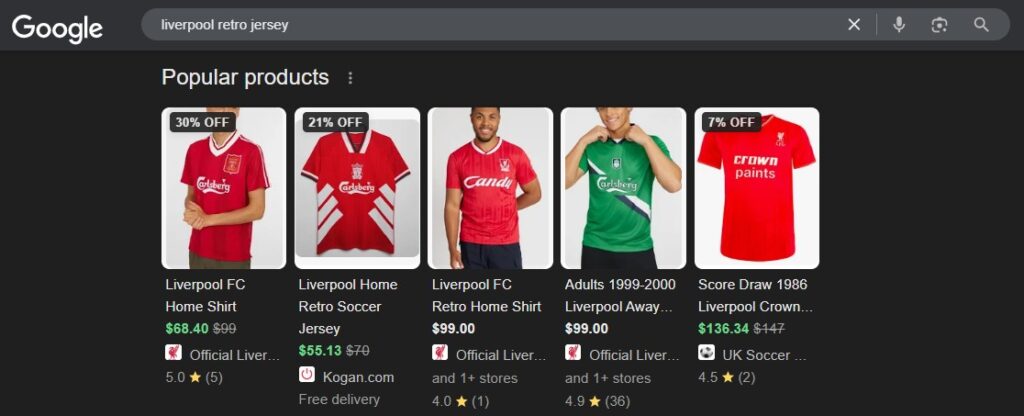
So strap in and lets unpack what free listings are, how they work and what you need to look at to get the most out of them.
Disclaimer: this is mostly concerning the current state of Australian search results, so you might see something a little different if looking at search results in a different country.
What are free listings on Google?
To explain free listings, first I need to tell you about paid listings. If you are already here, you probably have somewhat of an understanding about Google Shopping, which is managed through Google Merchant Center. These listings allow retailers to upload product information and advertise in search results, typically displaying right at the top, meaning they get a lot of visibility.
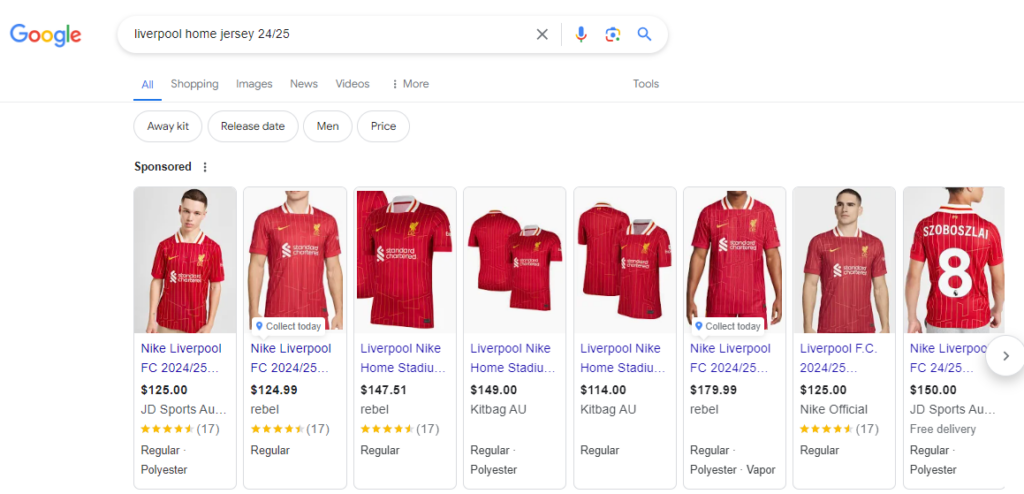
The other common place you will see these paid listings are if you use the shopping tab in Google search results. If it says sponsored above the section, then you’ve guessed it, you are looking at a paid listing, which advertisers have to pay for every time someone clicks. Other locations these listings can show up depending on your Google Merchant Center configuration includes YouTube, Google Images, Google Lens and on Google My Business / Google Business Profile listings within the product modules.
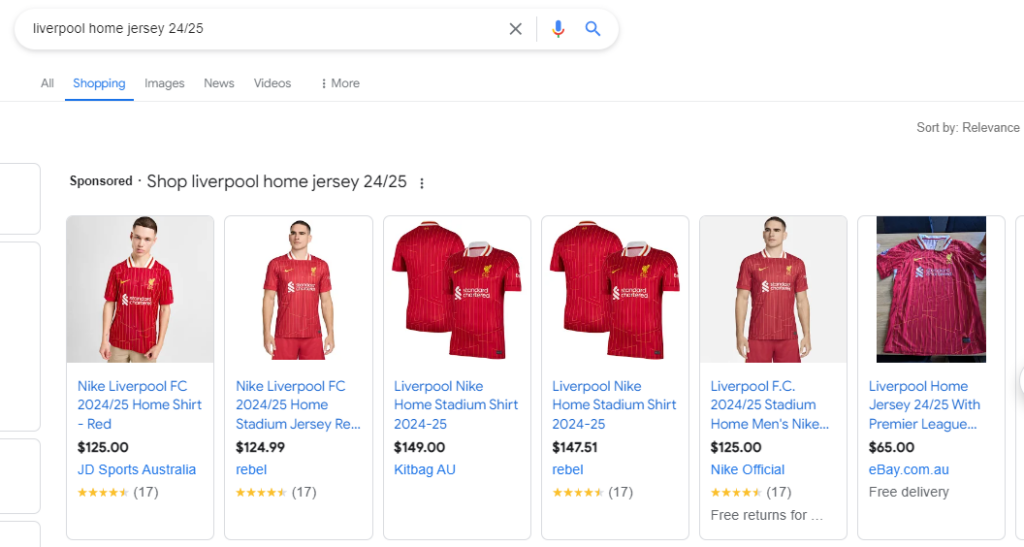
The way these paid listings work are you upload a feed, which contains all of the product information Google needs like names, pricing, stock levels etc and you can drive traffic to your site by paying for clicks, typically with Performance Max campaigns these days. Whilst it is focused on online performance, you can even use this to drive customers in-store by detailing local inventory levels. These feeds can be managed by feed partners, manually uploaded (which is pretty uncommon as requires accurate stock levels) or might automatically upload based on what CMS you use like Shopify.
Now, lets talk about the reason you are here, free listings. Free listings also use these feeds, as well as information that Google can pick up and verify on your site from crawling, to showcase your products at no cost to you, as long as your products are eligible. You’ve probably started to see more of these show in search as of the start of 2024, maybe without even noticing they were free listings! The type of search feature detailed below is an example of an organic product grid, which consists of free listings from multiple retailers. Note in the example below how the organic product grid, which in this example is for Popular Products, ranks ahead of any other organic result, highlighting they’re starting to dominate SERPs.
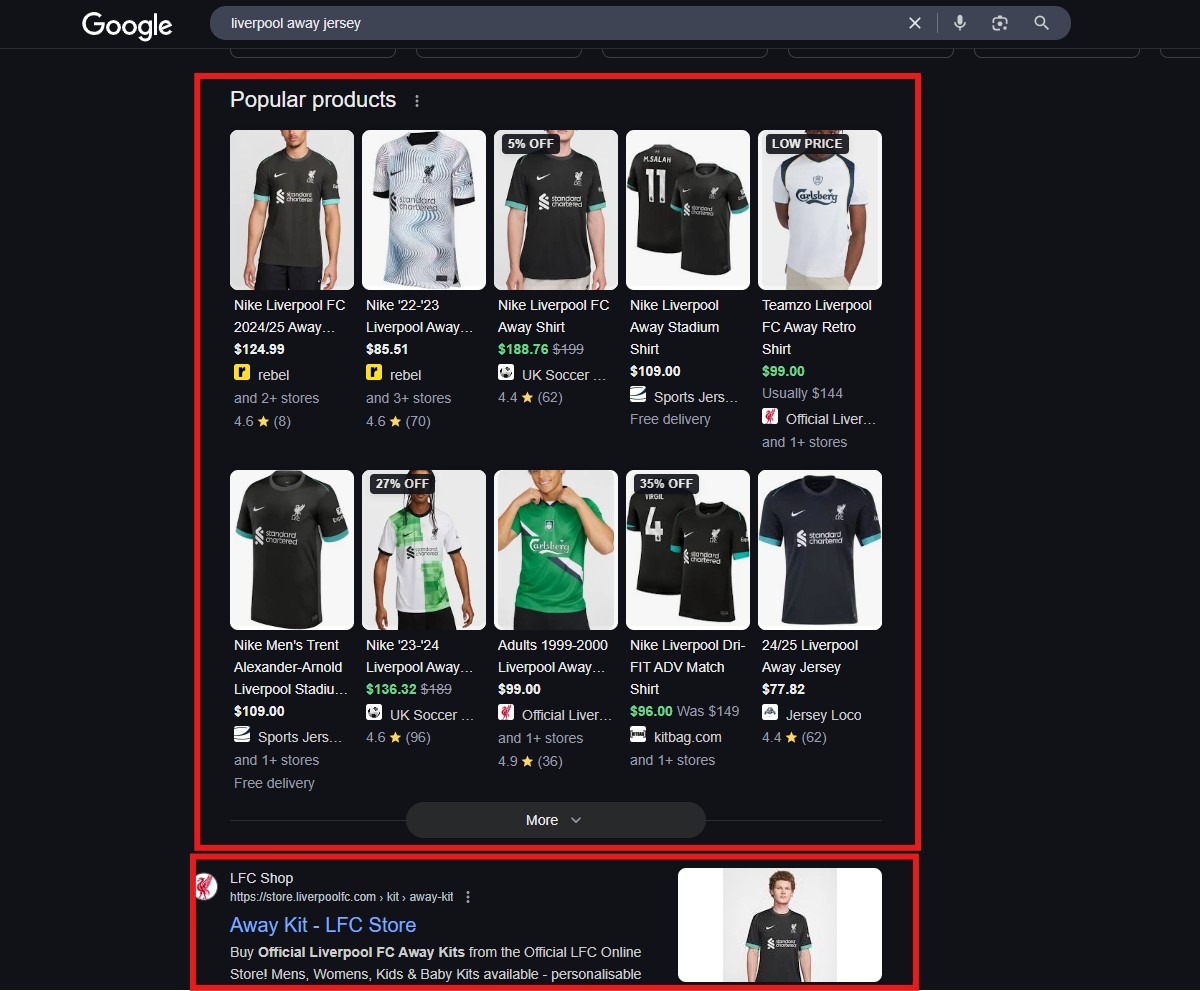
Another common location for free listings to be displayed in Google is within knowledge panels like below. These are usually for when you search for an exact product like “Philips 345E2LE 34″ Monitor”.

The reason this is becoming quite a popular point of interest within the SEO community is because of the changes in search results we are seeing and the increased visibility these listings are getting globally, and in particular in AU, US and UK.
The growth of organic product listings showing in SERPs
When I first wrote this article in May 2024, SEMrush Sensor suggested that close to 10% of all mobile searches and over 3% of desktop searches in Australia generated the “popular products” SERP feature, which is referring to the organic product grid. I speculated this would only grow, especially with the integration of AI into search results that we’ve seen in most markets.

Now looking a year later in May 2025, we can see that this has grown to around 14% of all mobile searches and 12% of desktop searches .

It’s also worth considering that for ecommerce specific searches that are more product focused (think someone googling “red long sleeve cardigan”) this percentage is way higher, with organic product grids showing over 45% of the time on mobile and 43% on desktop. Makes sense right? If someone is searching for a product, product grids are more likely to show.

If your business currently has free listings showing in search results, it is likely you would have seen some significant increases in visibility around early-mid 2024, which is where I saw a lot of growth for my clients (note the high CTR these listings can get!)
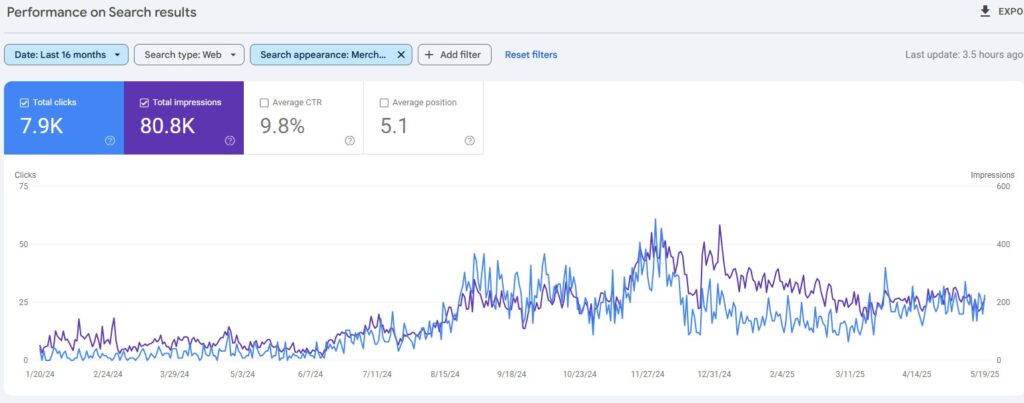
So hopefully now you have a bit of an understanding about what these types of listings are and that visibility for these free listings is growing steadily, showcasing why you should be focusing on this now. Let’s dive into how to improve your chances of ranking well in organic product grids and free listings.
What information does Google use to generate free product listings?
First and foremost, the feed that is uploaded to Merchant Center is the source of truth for Google. They will mostly use this to generate your free listings. But, remember I mentioned that Google crawls your website to verify what you have entered within your feed? Providing the right, optimised elements within your structured data and on-page elements can enhance your Merchant Center feeds and overall performance. If you have contradicting information within your feed that doesn’t match the information Google picks up through crawling your product structured data, you might not achieve great results or might even see your products disapproved.
I’m not going to jump into detail about product structured data and how that works as that isn’t the sole purpose of this article, but I would highly recommend you read Google’s blog on Adding structured data support for Product Variants and their general Introduction to Product structured data as this will detail what type of structured data is relevant to your business/website. What I will touch on however is how the elements within your structured data can support your free listing performance.
Google Merchant Center & Schema Checklist
I’ve put together a table that you can access through the link below that details how the elements within your product structured data are relevant to the specific elements you upload within your Google Merchant Center feed. Ideally they should match for the most part (but not always though). For example within the checklist you can see what the [brand] element means in Google Merchant Center and how you can support that with adding the relevant schema to your product pages, which might look like “brand”: {“@type”: “Brand”,”name”: “Birkenstock”}. The checklist doesn’t contain every single possible element in Google Merchant Center (that would be a nightmare for me to keep updating lol), but it does have all of the crucial elements that will be relevant to your products. Have a geeze, send me a message if you use it!
Alpha Digital – Merchant Center & Schema Checklist

How to improve your free product listing visibility
Start with ensuring products are approved and eligible for free listings
UPDATE: I have changed the descriptions and screenshots below to be relevant to Google Merchant Centre Next as all retailers have been automatically rolled out to this version.
Firstly, to see if your eligible for free listings, you need to start in Google Merchant Center. Under “MARKETING” within the lefthand navigation menu, click the “Free listings” option and if you can see “Your products can show in free listings across Google” then you are good to go. By default the Free listings feature should already be switched on if you are running any sort of sponsored ads anyway. If you can’t see this confirmation, it’s likely someone has switched this off intentionally and you’ll need admin level access to change this.
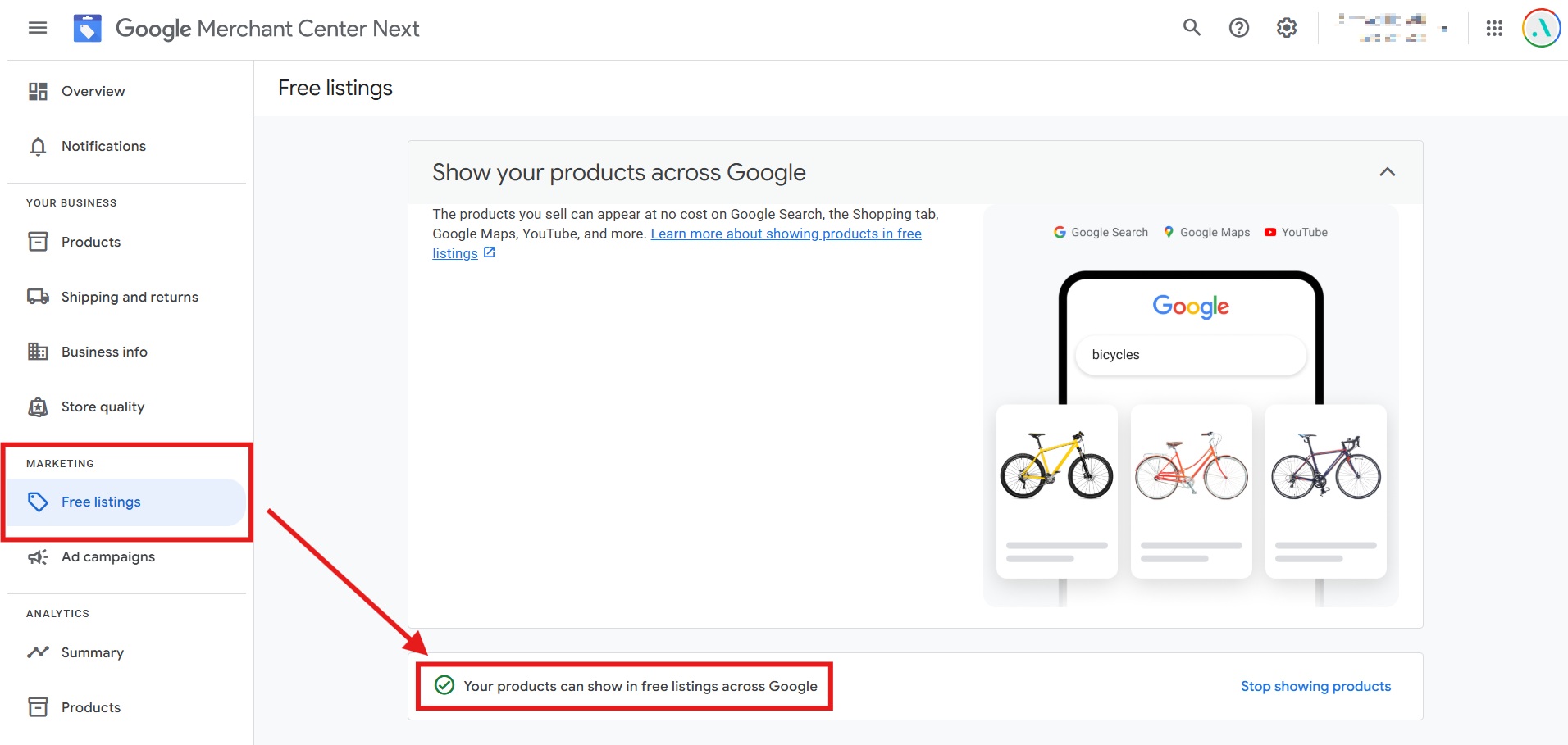
To ensure they are approved, there’s a few places you can check. First, within Merchant Center, Click the “Products” section within the lefthand menu navigation and then select “Needs attention”. You can then filer the “Marketing methods” to “Free listings” to see how many products are disapproved and what issues are disapproving your products. This is a great place to start and uncover the initial issues limiting your product visibility. Worth noting that it’s normal to see some disapprovals, for example if your feed contains OOS products that now point to a 404 page, these will be flagged here. When reviewing this list of recommended fixes, review each and ask yourself “should a customer be able to view this product and purchase?”, if so then look to fix it.
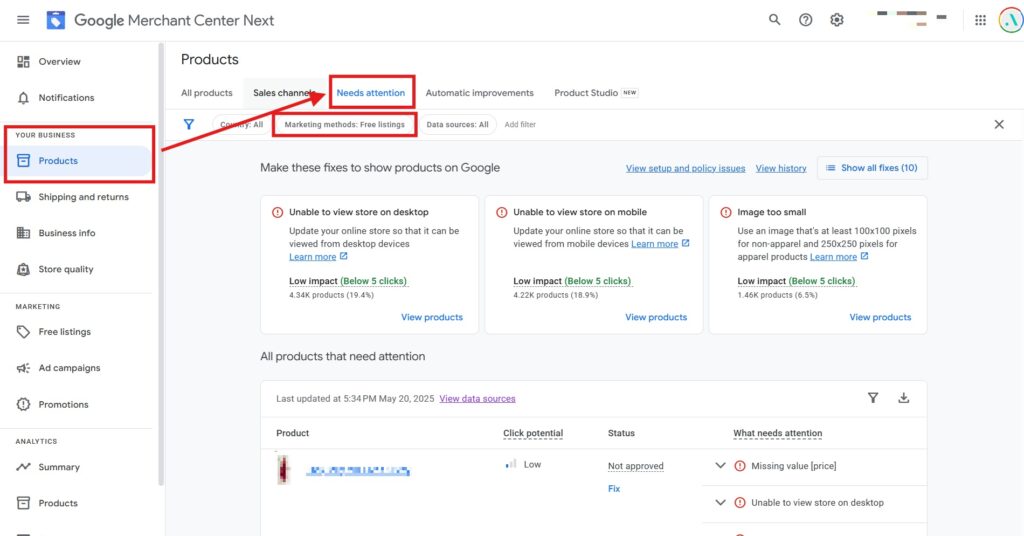
You can also view similar information within Google Search Console. To see valid products, navigate to the “Shopping” section within the lefthand menu navigation and select “Merchant listings”. If you can see a large proportion of invalid products with critical issues, these products may not be eligible for free listing search features. This is more relevant to the information Google picks up through crawling your site, as opposed to what is present within your Merchant Center feed. So for example if the issue warning is “Missing field size”, that means Google couldn’t find this within the structured data when they crawled the URL of that product.

Typically the amount of products that are valid within the “Merchant listings” section of Google Search Console should match the amount of valid products within the “Product snippets” section.
Obtain Top Quality Store Badge
Having this badge can really set your apart from other retailers, especially if your competitors are missing this detail. The Top Quality Store badge can improve confidence in users buying from you, help you rank higher within the shopping tab results and means your website is classified as an “exceptional” experience. To receive this badge you must provide an exceptional Shipping experience (delivery cost and delivery time settings), Return experience (return window and return cost settings), Browsing experience (image quality and page speed) and Purchase experience (promotion rejection rates and eWallet options).

You can view how you compare to your competition within the “Store quality” section in the left-hand side menu pictured above. This will give you a clear indication of how your business compares on average to others in your country and provide recommendations on how to improve by ensuring you have the right settings configured. I will touch on some of these factors in a little more detail below.
High resolution images / Images per offer
This feeds into your “Browsing experience” and contributes to your Top Quality Store badge. Within the “Shopping experience scorecard”, you’ll get a good indication of how you compare to other businesses within your industry. The amount of images you should have per offer will differ depending on what you are selling. View Google’s guide on valuable content for more details on what is considered good here.

Page speed
This feeds into your “Browsing experience” and contributes to your Top Quality Store badge. It’s quite easy for me to say “just improve your page speed” to improve your experience score here, however I know how much work goes into that. For most retailers, ensuring you have a healthy page speed is crucial to a wide range of factors like SEO, user experience and conversion rates, not just your free listings. If you have a low score here, this should be a priority for you to fix to enhance your overall website experience. Pro tip, use Google’s CrUX Vis tool to see where your website is lacking in terms of page speed and loading performance, this tool uses real customer data so isn’t skewed and is my go to.

Promotions
This feeds into your “Purchase experience” and contributes to your Top Quality Store badge. If your promotions in Google Merchant Center accurately reflects the discount that is promised when purchasing, than you shouldn’t have any problems here. You might run into issues if the promotion_id isn’t mapped correctly to applicable items within your product feed or if the product’s base price isn’t available on the product landing page. If you do see issues here, check out Google’s promotion status FAQs to troubleshoot
Multiple eWallet options
This feeds into your “Purchase experience” and contributes to your Top Quality Store badge. Google will crawl your site to verify which eWallet options your website is eligible for, which can take up to 30 days to validate. The eWallet options currently available to showcase here include PayPal, Google Wallet, Apple Pay and Amazon Pay. It goes without saying, Google can only add eWallet options that users can actually purchase with, so if your site doesn’t have the functionality for PayPal for example, you won’t be eligible to showcase that within here. So go on your website, add a product to you cart, checkout and see what payment options you have and then make sure you add them to Google Merchant Center where possible.

Delivery times and cost
This feeds into your “Shipping experience” and contributes to your Top Quality Store badge. This factors in how you compare to competitors within your industry for both cost of shipping and delivery times that you have set. I’ve seen that it’s pretty common to have the “Delivery time” as incomplete in here due to not finishing the configuration of this section. For example having a transit time set but not a cut off time which may be why you would see the incomplete warning for free listings. You can edit these settings to see what your business is currently configured for by clicking “Edit shipping details”.

Return window and cost
This feeds into your “Return experience” and contributes to your Top Quality Store badge. This one is pretty straightforward, just make sure that what you set as your return window and return cost actively reflects what you state within your return policies on your website.

Store ratings
Similar to the Top Quality Store badge, Store ratings can ensure confidence when shopping for potential customers. These can have wider benefits too for Google Ads, rich results and more, so definitely worth trying to improve your score where you can.


Google generates these scores based on store ratings it can find from reputable websites as well as from users on Google. If you don’t have reviews or a store rating yet, you can enable Google’s Customer Reviews program or a supported review partner. Read through Google’s store ratings overview for more information.
Good product reviews
For the organic product grid results, you’ll often find that the products that rank well have a high amount of quality product reviews. This is relevant to both your on-site reviews as well as the sourced reviews that Google groups together when showing products in organic product grids. You’ll notice that when you click on a product within the organic grid, the reviews counted are actually an aggregate score that is combined between retailers that sell that specific product. If you stock a product that is sold at multiple retailers that are evenly matched on price, you will need a unique edge to drive traffic as well as to rank competitively. If you don’t currently have the ability for users to leave reviews on your website, talk to your client or business about how this functionality can be integrated as it has wider benefits outside of free listings.
Price competitiveness
It is quite common for Google to rank cheaper products higher with organic product grids (not always the case though). If you think about Google’s purpose, it is to provide the most relevant results, so if users are consistently looking for the best priced options, this make’s sense. I’ve even seen some retailers take a dollar or two off their price to try and improve their positioning (and succeed with it). Consider how your products are priced compared to your competition, especially if you are a retailer who sells branded products that can be purchased at multiple retailers online.
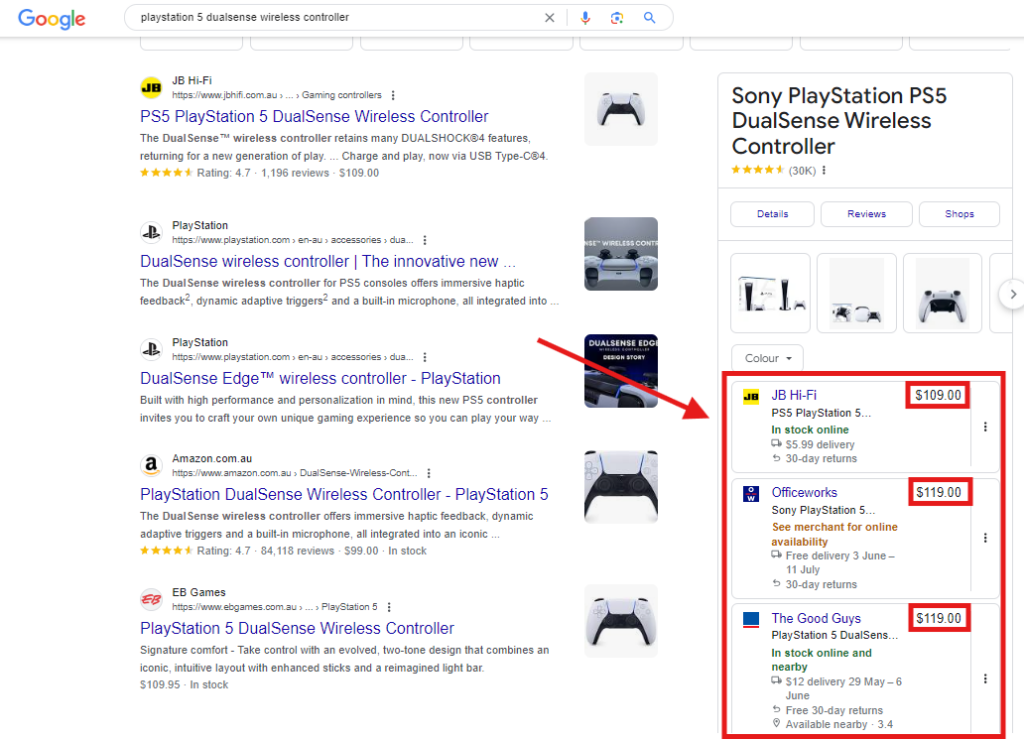
Optimised product titles
This one seems obvious however optimising your product titles is one of the first things I look at when trying to improve free listing performance and visibility. Your product title needs to accurately describe the product and match the title from your landing page (typically should match what you have within the title tag as well as the name within structured data). It needs to be keyword optimised to ensure you are using high search volume terms, but still needs to accurately reflect what your product is. Where possible include keyword relevant information that distinguishes the product from potential other variants like adding colour or the size of the product to the title. And yes, the below screenshot is what I wear to work on most days.

Free listings in summary
Free listings are showing in more and more search results, highlighting how important they are to include in your organic marketing strategies. This NEEDS to be part of your next SEO strategy and roadmap in order to stay competitive. While it can be a little daunting at first, once you dive into Google Merchant Center and understand the different elements and experiences that contribute to your potential rankings and how they correlate with your on-page structured data, it is a lot easier to digest.
Please reach out to me (here’s a link to my LinkedIn: Liam Challoner) if you have any questions on this one or if you have any amendments to make to this article, would love to chat about it. Happy optimising, cheers!

Free listings FAQs
What are free product listings?
Free product listings are results within Google that don’t require any cost per click and help retailers display their products to customers for relevant search results. These commonly appear within regular Google searches in the form of product grids and within the shopping tab.
Does the Google Shopping Feed show in organic search?
If you have opted in for free listings, than the products within your Google shopping feed can show in organic search, potentially within a product grid, knowledge panel or organically within the shopping tab in Google. By default, free listings are usually enabled if you have an active Google Merchant Centre feed with products running sponsored ads.
How do I opt in for free listings?
This depends if you already have Merchant Center set up for your business already. If not, you will be prompted to enable free listings when signing up. Assuming you do have Merchant Center set up already, click “Free listings” within the “MARKETING” section of the menu, then follow the prompts to enable free listings to show.
How do I track performance of free listings?
In Google Merchant Center Next you can easily track results within the “ANALYTICS” section of the lefthand menu navigation and then clicking “Products”. Just make sure you filter traffic to show “Organic” only.

In Google Search Console, you can view more information about specific keywords and landing pages driving traffic and impressions through free listings. Within the performance section, add a “Search appearance” filter for “Merchant listings” to see these results.
In GA4, you should be able to see the performance of these free listings within the ‘Organic Shopping’ channel. I have previously seen for some clients that the [link] attribute uploaded within the feed contain utm’s relevant to paid channels, when this should actually be attributed to organic, so double check this for your business to ensure it is being attributed correctly. I’d also recommend filtering your ‘Organic Shopping’ channel to only contain source / medium’s that equal google / organic, as GA4 will often pull in referral sources into this report, which is usually not accurate.